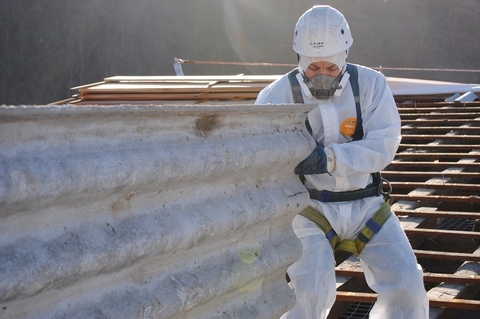This may be hard to believe, given that it’s now outlawed due to its adverse impact on human health, but asbestos was once considered a “miracle mineral.” Because asbestos is abundantly available and has some industrially useful properties, it was very popular in commercial and residential construction throughout most of the 20th century. In fact, it wasn’t completely banned from building products in the U.S. until 2019.
When a structure built between 1900 and 1990 incurs damage — due to a leak, natural disaster or other loss event — there’s a fair chance the presence of asbestos will be discovered during the cleanup, demolition or repair process. To protect the well-being of the building’s occupants and post-loss work crews, damaged areas must be inspected and handled with care by skilled professionals who can effectively mitigate the potential risks. In this blog, I will explore the properties and health effects of asbestos and the important role of expert specialists in limiting dangerous exposures, controlling costs, and ensuring regulatory compliance when a property damage claim involves asbestos.
What made asbestos so popular
Asbestos is a lightweight crystalline substance that occurs in nature and can be mined. It is resistant to fire and many chemicals, insoluble in water, a good electrical insulator and has high tensile stress (meaning it can withstand heavy stretching and pulling without breaking). Its long fibers are flexible, and some can even be woven. Experts estimate asbestos has more than 2,000 distinct uses.
Its strength and durability made it a perfect fit for use in construction — in everything from floor and ceiling tiles to drywall, insulation, siding, joints, roof shingles, ductwork and more. As an environmental consultant, I’m often asked where in a building asbestos can be found. The short answer is: anywhere and everywhere.
Why it’s so harmful
The use of asbestos fell out of favor and was heavily regulated when its long-lasting and damaging health effects came to light. The qualities that contributed to asbestos’s popularity for construction are the same ones that make it so harmful to people; it is very strong and therefore doesn’t break down in the body.
Asbestos-containing materials can release particles and fibers into the air when they are disturbed or damaged. If breathed in, those particles become trapped in the body and can lead to lung cancer, mesothelioma (rare cancer in the thin lining of the lungs and other organs), asbestosis (chronic lung disease and shortness of breath) and other serious health issues. These conditions can develop many years after exposure. Approximately 10,000 Americans die each year from asbestos-related diseases.
Because of the severity of these risks, the handling of asbestos is highly regulated. At the federal level in the U.S., the Occupational Safety and Health Administration (OSHA) and Environmental Protection Agency (EPA) have established standards regarding asbestos safety. Multiple U.S. states and municipalities have their own regulations related to the training and licensing of professionals who work with asbestos, air monitoring criteria and other factors. Because the requirements vary by location, licensed asbestos consultants must familiarize themselves with the jurisdictional nuances and continually monitor the regulatory landscape for updates.
How to identify asbestos and what to do next
The date a building was erected may hint to the use of asbestos in its construction, but only material sampling and lab testing can determine that for certain. These should always be performed by a licensed environmental consultant. Based on their training, professional expertise and knowledge of the governing standards and regulations, they can determine the best course of action for abatement. The options include maintaining the asbestos-containing materials in place, removal, enclosure, encapsulation or some combination thereof. The amount of asbestos, its condition, location, probability of disturbance and timing of abatement are all critical factors in making informed abatement decisions.
Many assume that asbestos must be removed from a structure in order to make it safe. But that’s not always the case, and that assumption can cost building owners and companies thousands of dollars in unnecessary abatement costs and business interruptions. Oftentimes, asbestos-containing materials can remain safely undisturbed and are safer left untouched than cut into or removed.
By way of example: My team at EFI Global was enlisted on a water damage claim at a healthcare facility that was covered by a major insurer. A national asbestos removal and contracting firm had inspected the loss site, identified the presence of asbestos, and proposed the removal of all sheetrock on the walls throughout one wing of the building. The job was quoted at more than $300,000 and an estimated 15 days of work. One of our expert environmental consultants subsequently conducted a thorough investigation and determined that far less work was needed to ensure the facility’s safety. We recommended a two-foot flood cut in most areas affected by the water damage and estimated the necessary asbestos removal would cost about $10,000, including disposal fees and post-abatement testing. Our efforts saved our insurer client a significant amount of money on the claim and prevented the policyholder from undertaking more hassle and disruption than necessary.
It’s important to keep in mind that the interests of environmental consultants and abatement contractors are not always aligned. Turning to the right expert professionals at the right time can control claim costs while ensuring safety and full compliance.
> Learn more — read about EFI Global’s full range of fire investigation, engineering, and environmental, health and safety consulting services in our brochure, and register today for Bruce Burton’s virtual continuing education course, “Asbestos consulting and abatement issues: a critical part of claims processing” happening on December 6, 2023.
Tags: health, health and safety, health concerns

